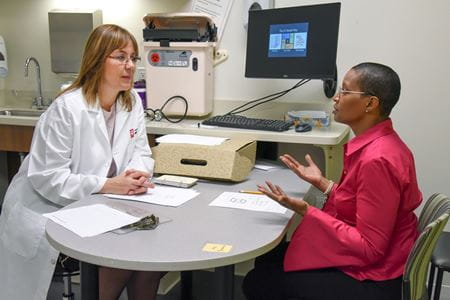INDIANAPOLIS—For the fifth-straight year, Indiana University School of Medicine set a school record for research funding received from the National Institutes of Health, showcasing its continued leadership in the field of medical research.
IU School of Medicine scientists and physicians were awarded more than $213 million in NIH research funding in the 2020 federal fiscal year—netting about $24 million more than the school record from the previous year and surpassing the $200 million mark for the first time in school history. Over the past five years, the school has increased its NIH funding by more than $104 million, or 95 percent.
The NIH is the lead federal agency responsible for biomedical and public health research, and NIH grants are the most sought-after funding for researchers. The school retains its place among the leading researchers in the fields of Alzheimer’s disease and pediatrics.
Combining grants across several disciplines, the school ranked fifth in the country in funding from the National Institute on Aging, the NIH branch that is the primary funder of Alzheimer’s disease research. And once again, the Department of Pediatrics ranks sixth out of all U.S. departments of pediatrics.
“Our continued growth in NIH funding is a testament to the leadership and expertise of our faculty. I extend my thanks for their tremendous effort,” said Jay L. Hess, MD, PhD, MHSA, dean of IU School of Medicine and IU’s executive vice president for university clinical affairs. “NIH grants are the gold standard for research funding, but most importantly this fuels our work in finding answers for some of the most challenging questions. As we continue to navigate the pandemic, this is more important than ever.”
According to a report by United for Medical Research, every $1 million in NIH funding awarded to Indiana researchers created 18 jobs and $2.7 million in economic activity in 2019. Based on that data, IU School of Medicine’s 2020 NIH funding is responsible for more than 3,768 jobs—with 2,755 of those jobs existing here in Indiana. The income from those jobs, along with other associated expenses, generates an estimated $585 million annually in economic activity.
“Seeing our funding continue on this remarkable upward trajectory is such a powerful testament to the quality and strength of our research enterprise,” said Tatiana Foroud, PhD, Executive Associate Dean for Research Affairs and Chair of the Department of Medical and Molecular Genetics. “As a leader I am proud to work with our great team of Indiana University School of Medicine scientists. As a researcher, the advances we are making as an institution will continue to motivate each of us to push the boundaries of science.”
Strategic investments in talent and infrastructure have continued to boost research productivity at IU School of Medicine and highlight the commitment of school leadership to addressing the most pressing health challenges in Indiana and beyond. For the second year in a row, four of the five research studies that received the most NIH funding were for Alzheimer’s disease research, in alignment with the school’s top priorities.
The top-funded study with nearly $16 million in NIH support last year was the Longitudinal Early-Onset Alzheimer’s Disease Study (LEADS) led by Liana Apostolova, MD. The focus of the LEADS study is a form of Alzheimer’s disease that afflicts patients between the ages of 40 and 65. At No. 2 was the Indiana University/Jackson Laboratory Model Organism Development & Evaluation for Late-Onset Alzheimer’s Disease. Led by Bruce Lamb, PhD, Executive Director of the Stark Neurosciences Research Institute, the study focuses on developing new laboratory models to study the disease and test potential therapies.
Other top Alzheimer’s grants include:
- The school’s Target Enablement to Accelerate Therapy Development for Alzheimer’s Disease (TREAT-AD) center, one of two such centers funded by the NIH to develop new drug targets for Alzheimer’s disease.
- The National Centralized Repository for Alzheimer’s Disease and Related Dementia, which is led by Foroud and collects and distributes biological samples like DNA, plasma and tissue from patients with dementia for use in research locally and nationally.
With more than $32 million in grants, the Department of Pediatrics remained ranked at sixth in the nation—accounting for 15 percent of the school’s total NIH funding. Among the 69 studies the department received NIH funding for were sizable grants for work on cystic fibrosis therapies and congenital heart defects in babies.
Other key areas of focus for IU School of Medicine are cancer, global health and precision genomics, a priority of the IU Precision Health Initiative Grand Challenge.
Along with pediatrics, IU School of Medicine saw two more departments join the top 20 rankings—bringing the total to eight. The Department of Anatomy, Cell Biology & Physiology jumped 13 spots to rank 15th among all other departments in that field nationally. The Department of Orthopaedic Surgery also placed in the top 20, moving eight spots to the rank of 18. They join: Biostatistics (12), Emergency Medicine (11), Medical and Molecular Genetics (10), Neurology (17), Otolaryngology (15) and Pediatrics (6).
Overall, IU School of Medicine ranks 14th among public medical schools, and 29th overall in NIH funding nationally.
Additional information can be found at go.iu.edu/research.
Contact: Katie Duffey, kaduffey@iu.edu or 317-278-3630
####
About IU School of Medicine
IU School of Medicine is the largest medical school in the U.S. and is annually ranked among the top medical schools in the nation by U.S. News & World Report. The school offers high-quality medical education, access to leading medical research and rich campus life in nine Indiana cities, including rural and urban locations consistently recognized for livability.




